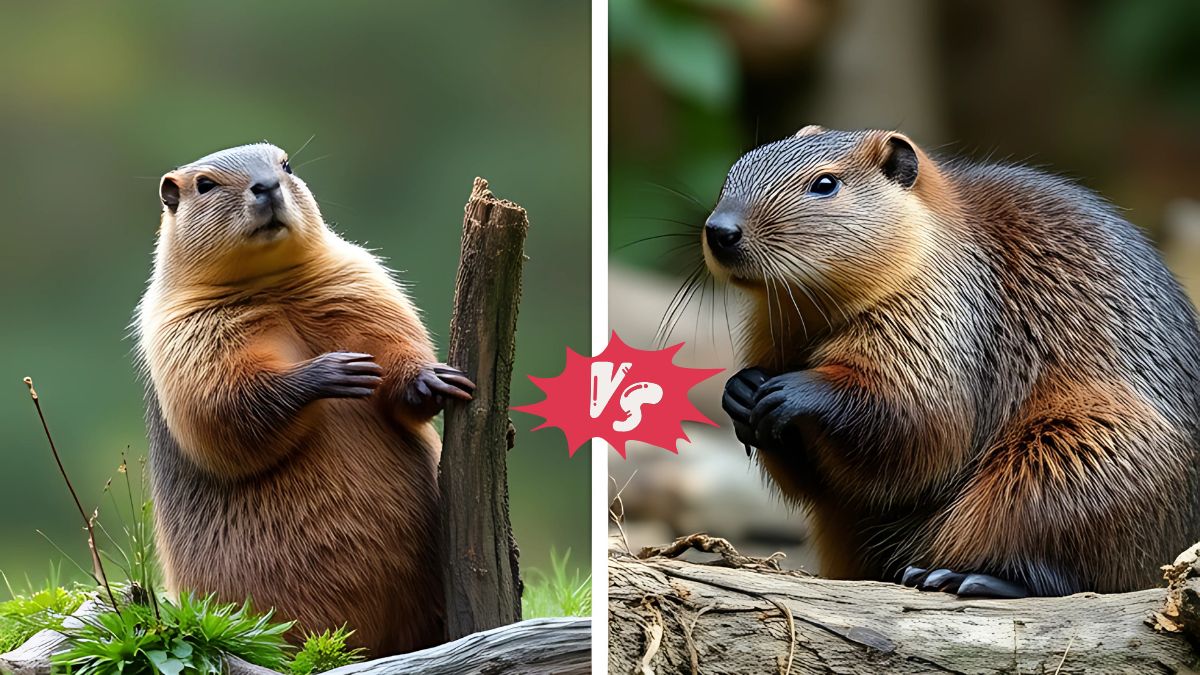When it comes to rodents in North America, woodchucks (also known as groundhogs) and beavers are two of the most recognized species. Despite some physical similarities, they are vastly different in behavior, habitat, diet, and ecological roles. In this article, we will explore the differences and similarities between woodchucks and beavers, providing an updated look based on today’s knowledge and ecological data.
Overview of Woodchucks and Beavers
Woodchuck (Marmota monax)
- Commonly referred to as groundhogs.
- Belong to the squirrel family (Sciuridae).
- Known for burrowing and hibernation.
- Primarily terrestrial and solitary animals.
Beaver (Castor canadensis)
- A large, aquatic rodent.
- Belong to the beaver family (Castoridae).
- Famous for building dams and lodges.
- Semi-aquatic and highly social creatures.
Both animals are vital for their ecosystems, but their lifestyles and roles differ significantly.
Key Differences Between Woodchucks and Beavers
| Feature | Woodchuck | Beaver |
| Scientific Name | Marmota monax | Castor canadensis |
| Family | Sciuridae (squirrel family) | Castoridae (beaver family) |
| Size | 16–20 inches (40–50 cm), 5–10 lbs (2–4 kg) | 39–47 inches (1–1.2 m), 35–60 lbs (16–27 kg) |
| Tail | Short and bushy (4–7 inches) | Long and flat (10–15 inches) |
| Habitat | Grasslands, forests, and open areas | Rivers, ponds, and wetlands |
| Diet | Herbivorous; grasses, vegetables, fruits | Herbivorous; tree bark, leaves, aquatic plants |
| Activity | Primarily terrestrial and diurnal | Semi-aquatic and crepuscular/nocturnal |
| Lifespan | 6–8 years in the wild | 10–15 years in the wild |
| Behavior | Solitary | Social; live in family groups |
| Unique Feature | Excellent diggers and hibernators | Skilled dam builders |
Physical Differences
- Size and Weight
Beavers are significantly larger than woodchucks. The average beaver can weigh up to six times more than a woodchuck. Additionally, the long, flat, paddle-like tail of a beaver contrasts sharply with the short, bushy tail of a woodchuck. - Fur and Appearance
Both species have thick fur, but beavers have denser, waterproof fur suited for aquatic life. Woodchucks, adapted to life on land, have fur that is less dense but provides insulation during hibernation. - Teeth
Both rodents have strong, ever-growing incisors. Beavers’ teeth are particularly adapted for gnawing through wood, while woodchucks primarily use theirs for chewing plants.
Habitat and Behavior
Woodchucks
- Burrowing Experts: Woodchucks are known for digging extensive burrow systems that can be 30 feet long and have multiple entrances.
- Hibernation: They hibernate during the winter, slowing their metabolism and surviving on fat reserves.
- Solitary Creatures: Unlike beavers, woodchucks prefer solitude, only seeking companionship during the breeding season.
Beavers
- Dam Builders: Beavers are skilled architects, creating dams and lodges out of logs, mud, and stones. These structures create wetlands, which support diverse ecosystems.
- Semi-Aquatic Life: Beavers spend much of their time in the water and are excellent swimmers.
- Family-Oriented: Beavers live in colonies consisting of a breeding pair and their offspring.
Dietary Habits
Both species are herbivorous, but their diets reflect their environments.
- Woodchucks eat a variety of vegetation, including grasses, flowers, fruits, and agricultural crops like corn.
- Beavers, on the other hand, consume woody plants such as aspen, willow, and birch, as well as aquatic vegetation like water lilies.
Ecological Impact
Woodchucks
- Soil Aeration: Their burrowing helps aerate the soil, which can benefit plants.
- Predator Prey Cycle: They serve as prey for various predators, such as hawks, foxes, and coyotes.
- Agricultural Pests: They are often seen as pests due to their tendency to feed on crops.
Beavers
- Ecosystem Engineers: Beavers are considered a keystone species. Their dams create wetlands that provide habitats for fish, amphibians, birds, and other animals.
- Water Management: Beaver dams reduce flooding and improve water quality by trapping sediments.
Adaptations to Modern Threats
Both woodchucks and beavers face challenges due to habitat loss and human activity. However, their adaptability allows them to survive in suburban and rural areas.
Woodchucks
Woodchucks have adapted well to human-modified landscapes. They often dig burrows near gardens, lawns, and farms, leading to conflicts with humans.
Beavers
Beavers face threats from dam destruction, trapping, and habitat encroachment. However, their positive impact on ecosystems has led to conservation efforts, including reintroduction programs in areas where they were previously eradicated.
Fun Facts About Woodchucks and Beavers
- Woodchucks and Groundhog Day
Woodchucks are famous for their role in Groundhog Day, a tradition where their shadow is believed to predict the weather. - Beaver’s National Symbol
The beaver is Canada’s national animal, symbolizing industry and perseverance. - Dental Adaptation
Both rodents have orange-colored teeth due to the iron content, which strengthens their incisors.
Summary of Key Differences
| Aspect | Woodchuck | Beaver |
| Role in Ecosystem | Soil aeration and prey species | Keystone species; wetland creators |
| Human Interaction | Often seen as pests due to burrowing | Generally beneficial but can cause flooding |
| Conservation Status | Least Concern | Least Concern |
Conclusion
While woodchucks and beavers share some similarities as rodents, their differences in habitat, behavior, and ecological roles highlight their unique contributions to nature. Woodchucks excel in terrestrial environments with their burrowing skills, while beavers are aquatic engineers that reshape entire landscapes. Understanding these differences not only helps us appreciate their ecological importance but also fosters coexistence in areas where human activity overlaps with their habitats.
